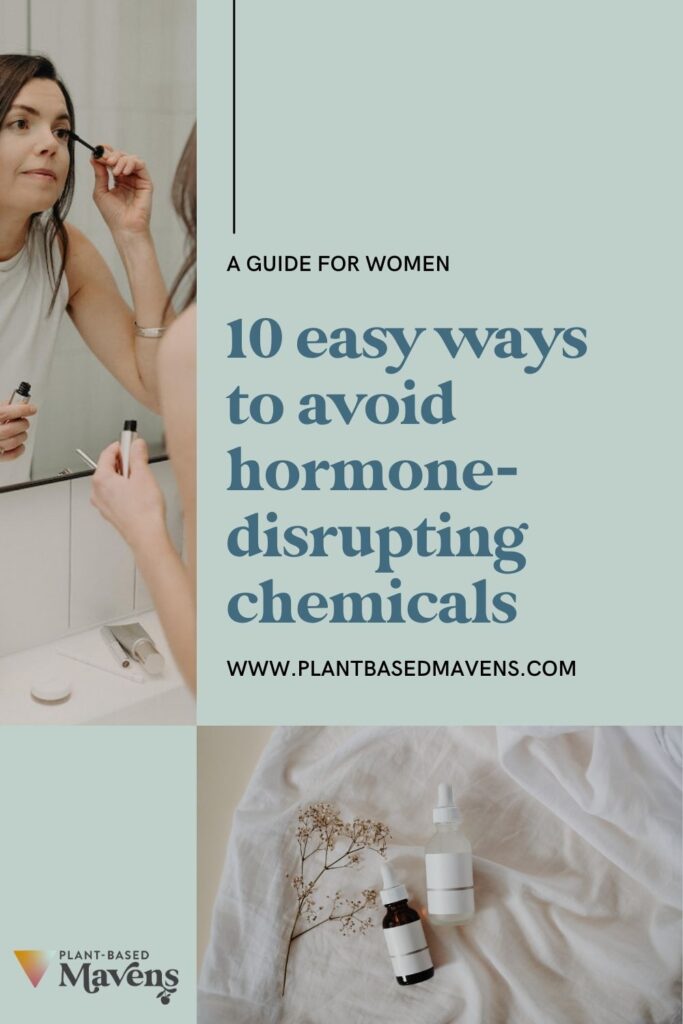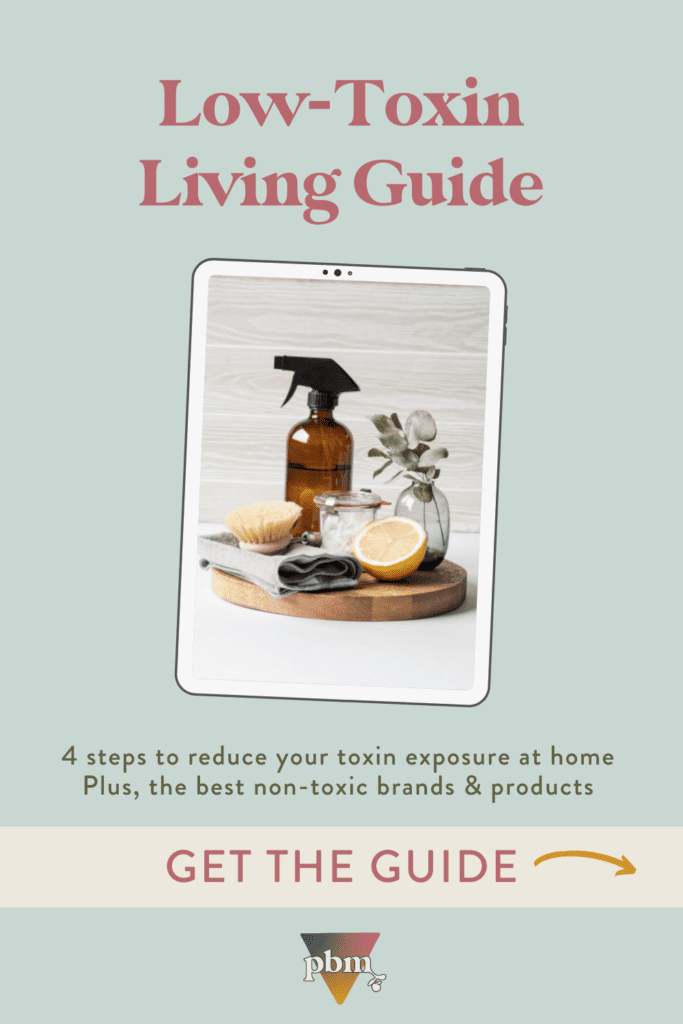The endocrine system is your body’s network of glands that produce hormones that regulate our growth and development, reproduction, sex drive, body weight and metabolism, sleep, mood, and many other functions. You can think of your hormones as little messengers that deliver signals to different parts of your body, telling it exactly what to do. So, what are hormone-disrupting chemicals? Chemicals called “endocrine disruptors”, or EDCs, can interfere with your delicately balanced endocrine system, leading to serious health consequences. The good news: there are steps you can take to reduce your exposure to EDCs.

What are endocrine disruptors?
Endocrine disruptors are hormone-disrupting chemicals that interfere with the body’s endocrine system and cause adverse effects. They can lead to negative developmental, reproductive, neurological, and immune effects. They’re found in everything from plastic products, to cosmetics, to furniture and clothing fabrics.
When endocrine disruptors are absorbed into your body from a source of exposure, they interfere with hormone function by mimicking or blocking hormones. A classic example of this are chemicals called xenoestrogens that mimic the action of estrogen in the body. Xenoestrogens are often found in pesticides, herbicides, and other agricultural products. They can bind to estrogen receptors and activate them, leading to an excessive estrogenic effect. This can disrupt the normal hormonal balance and potentially lead to adverse health effects.
Other types of endocrine disruptors can interfere with different hormones in the body. For example, some chemicals can disrupt thyroid hormones, which play a crucial role in regulating metabolism, growth, and development. Others can interfere with the function of adrenal hormones, which are involved in managing stress and regulating blood pressure.
These hormone-disrupting chemicals can enter our bodies through various routes of exposure. They can be inhaled, ingested through food or water, or absorbed through the skin. They can also be passed from mother to baby during pregnancy or breastfeeding. Once inside the body, these chemicals can accumulate and persist, causing long-term effects on our health.
The effects of endocrine disruptors can vary depending on factors such as the timing of exposure and the dose of the chemical.
Why are endocrine disruptors so dangerous for women?
Endocrine disruptors are especially dangerous for women. Exposure to EDCs have been linked to menstrual cycle disruption, premature puberty, early onset menopause, endometriosis, infertility, PCOS, and thyroid issues in women.
Women are also more likely to be exposed to these hormone-disrupting chemicals as the primary users of most personal care products, cosmetics, and home cleaning products. It’s estimated that women are exposed to 168 chemicals a day just from the use of an average of 12 or more personal care products, and women and girls with the highest use of personal care products and cosmetics have the highest blood levels of the chemicals in the products. Pregnant women who use cosmetics have also been found to have significantly elevated chemical blood levels.
The health impact of environmental toxins like endocrine disruptors is so real that the American College of Obstetricians and Gynecologists (ACOG) recommends that OBGYNs ask women about their toxin exposure at initial prenatal visits. Prenatal exposure is especially troublesome because it impacts both mom and baby!
One of the key concerns is the impact of endocrine disruptors on female reproductive tract development. Exposure to these chemicals, such as the well-documented case of DES, can result in abnormalities in the uterus, oviducts, and cervix. These structural changes can increase the risk of ectopic pregnancy, preterm delivery, miscarriage, and infertility, all of which have serious implications for women’s reproductive health.
Furthermore, endocrine disruptors have been linked to the development of uterine leiomyomas, also known as fibroids. These benign tumors can cause significant morbidity for women, leading to symptoms such as heavy menstrual bleeding, abdominal pain, pelvic prolapse, and infertility.
Overall, the impact of endocrine disruptors on fwomen is concerning and underscores the need for further research and regulatory measures to protect women from these harmful substances, especially prenatal exposures. Increased awareness of the potential risks associated with exposure to endocrine disruptors is essential for safeguarding women’s reproductive and overall health.
What are the most common hormone disruptors?
The Environmental Working Group’s Dirty Dozen Endocrine Disruptor List shows the top 12 hormone-disrupting chemicals to avoid:
- BPA
- Dioxin
- Atrazine
- Phthalates
- Perchlorate
- Fire retardants
- Lead
- Arsenic
- Mercury
- Perfluorinated chemicals (PFCs)
- Organophosphate pesticides
- Glycol Ethers
What household items are hormone disruptors?
The sad truth is that exposure to EDCs primarily comes from chemicals in products we use every single day! Household items can be a major source of endocrine disruptors. These disruptors can have harmful effects on our health, including reproductive issues, cancers, and neurodevelopmental disorders. It is important to be aware of these items in order to reduce our exposure to these harmful chemicals.
Some of the most common household items and consumer products that contain endocrine disruptors include:
- Food packaging: Bisphenol A (BPA) is a chemical commonly found in food storage containers and can leach into our food, especially when heated. It can mimic estrogen in the body and disrupt hormonal balance.
- Non-stick cookware: Perfluoroalkyl and Polyfluoroalkyl Substances (PFAS) are used in non-stick coatings on cookware and can be harmful to our hormone system. They have been linked to reproductive issues and hormonal imbalances.
- Personal care products: Many personal care products, such as lotions, shampoos, and cosmetics, contain phthalates, which are known endocrine disruptors. These chemicals can be absorbed through the skin and disrupt hormonal functions in the body.
- Cleaning products: Some cleaning products contain phthalates and other chemicals that can act as endocrine disruptors. It is important to choose cleaning products that are free of these harmful chemicals to reduce our exposure.
- Air fresheners: Air fresheners often contain synthetic fragrances that can contain phthalates and other endocrine disruptors. These chemicals can be inhaled and enter the body, affecting our hormone system.
By being mindful of the consumer products we use and choosing products that are free of endocrine disruptors, we can reduce our exposure to these harmful chemicals and protect our health. It is important to read labels, choose natural and organic products whenever possible, and limit the use of products that contain these harmful chemicals.

10 Ways To Avoid Common Endocrine Disruptors
You might be wondering how to take this list of unfamiliar chemical names and translate them into your real life. Here are 7 steps you can take to start reducing your exposure to endocrine disruptors.
Wash hands
Washing hands frequently with soap and water can be an effective way to limit exposure to endocrine-disrupting chemicals found in everyday products. Since EDCs are present in many things we touch throughout the day like receipts and plastic bottles, removing them from the skin through handwashing can help reduce the risk of absorption into the body and minimize exposure to EDCs.
Open your windows
Opening windows in your home can help reduce exposure to endocrine-disrupting chemicals by allowing for better ventilation and air circulation. By letting fresh air in, you can help dilute and disperse any indoor air pollutants that may be present, including chemicals from cleaning products, plastics, and fragrances. Even furniture, rugs, and building materials can off gas toxic chemicals into the air. This simple act can help create a healthier indoor environment and minimize the potential harmful effects of endocrine disruptors.
Vacuum and clean your home often
Vacuuming and cleaning your home regularly can significantly reduce your exposure to synthetic chemicals, such as flame retardants and phthalates, that can disrupt hormones. Dusting with a damp cloth and using a vacuum cleaner with a HEPA filter can help trap small particles of dust and prevent them from circulating in your home. By reducing the amount of dust in your home, you can also decrease your exposure to other harmful chemicals that may be present, such as lead and fluorinated chemicals. .
Swap plastics in the kitchen
Endocrine disruptors in plastics are one of the first types I recommend clearing out. Plastics contain hormone-disrupting chemicals like BPA and phthalates which are linked to breast cancer, fertility issues, and premature puberty. Even the American Academy of Pediatrics cautions against microwaving things in plastic containers because these harmful chemicals can leach into food. Swap plastic storage containers and plastic water bottles for glass or stainless steel, avoid wrapping foods in flimsy plastic cling wrap, and transfer food to microwave-safe glass containers before heating.
Say no to receipts
This is the easiest way to lower your exposure to toxins. The thermal paper that receipts are printed on contain BPA and BPS, and the exposure from receipts is so alarming that Connecticut has actually banned its use. California may also soon do the same. Trader Joe’s announced in 2018 that they would be removing these chemicals from their receipts too. Opt for an emailed receipt, decline the receipt, or if you must take the receipt be sure to wash your hands immediately.
Filter water
Tap water can contain endocrine disruptors like heavy metals and residues from pharmaceuticals. The Environmental Working Group recommends reverse osmosis filters as the most effective, but even common carbon filter water pitchers can reduce your exposure. Check out their water filter guide to choose the right filter for you.
Choose clean cookware
Conventional non-stick cookware like Teflon contains a family of chemicals known as PFAS chemicals. Even in low doses, these chemicals are linked to certain cancers, immune suppression, early puberty, and thyroid disruption. Trade non-stick cookware for cast iron, stainless steel, or enamel. There are also some non-toxic non-stick cookware brands available. Download the Low-Toxin Living Guide for my favorite brands.
Go natural with fragrance
Synthetic fragrances found in everything from body lotion to dryer sheets contain phytates which are linked to birth defects, lower sperm count, gestational diabetes, and miscarriages. To avoid this endocrine disruptor, don’t buy products that list phytates or the black box terms “fragrance” or “parfum” on the label. Either buy fragrance-free products (I know… bummer!) or products scented naturally with essential oils.
Check your cosmetics and personal care products
Endocrine disruptors in cosmetics and body care products are a big issue for women since we are the primary users of these products. You would be shocked by many of the ingredients in these products. The average woman will use about 10,000 tampons or pads in her lifetime, and neither the EPA or FDA has authority to regulate the ingredients in these products. Most contain chemicals called parabens which have estrogenic effects.
The easiest way to navigate clean beauty is to search for products using the Environmental Working Group’s Skin Deep Database.
Simplify your cleaning products
It’s probably not surprising to you that home cleaning products contain chemicals. Not only do these chemicals cover surfaces that we come in contact with, they also linger in the air where we breathe them in. The surprising part is that you can have a clean (and safe) home with just a few everyday ingredients that you likely already have on hand. Get my favorite DIY home cleaner recipes in the Low-Toxin Living Guide. I also share my favorite clean brands if DIY is not your thing!



